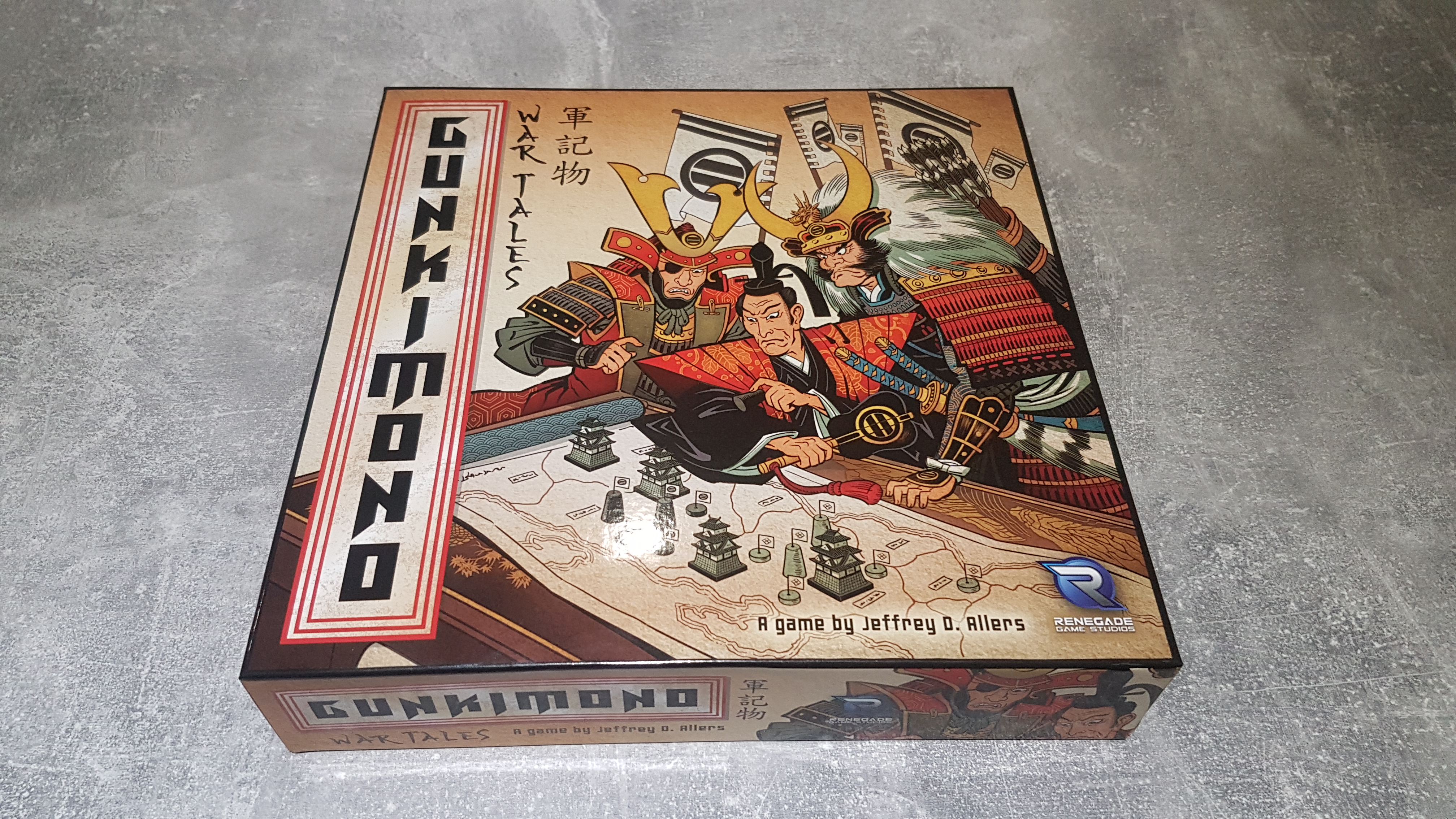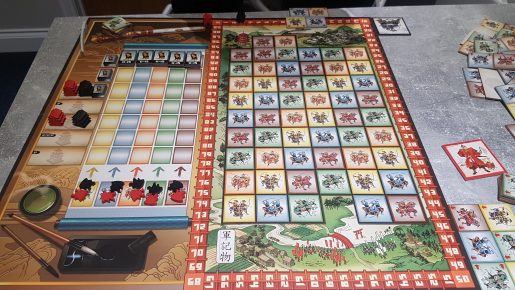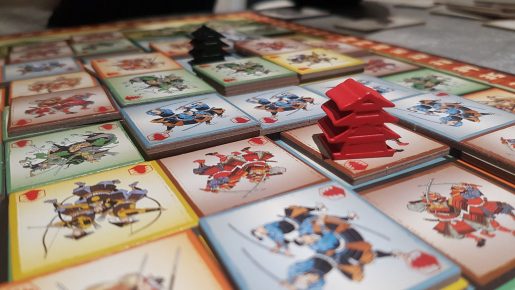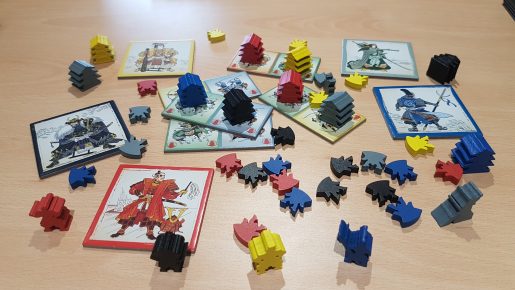Gunkimono is a Samurai themed territory building board game from publisher Renegade Game Studios. Designed by Jeffrey D. Allers, the game is a reimplementation of the 2009 title Heartland – moving away from farms to a war-torn feudal Japan setting. Taking on the role of daimyos 2 – 5 players will spend around 50 minutes placing troops, earning honor and building strongholds. However, is this a battle you will want to be part of? Let’s find out!
Setup has a few steps aside from the standard things like placing the game board in the middle of the table. War banners are shuffled in their separate types and are added to the board at the top of the honor track columns, in order of Lotus, Crane and Dragon – effectively making the piles decrease in points as tokens are taken. Choosing a colour each player adds their daimyo meeple onto the score tracker, 5 honor markers to the bottom of the 5 honor columns and their two stronghold pieces to the indicated places at the edge of the honor tracks.
Determined by the player count a number of large rectangle army tiles are shuffled and placed face down in stacks. Five large army tiles are randomly removed from stacks and a end game trigger tile is shuffled in, to create an end game stack which can be left off to one side. The rest of the stacks are lined up next to the board and three tiles are flipped to create a market. Each player then draws a total of three large army tiles from the face down stacks. They are also given 1 square small army tile of each of the 5 colours, the same colours as the 5 honor columns. After randomly deciding the starting player the game is ready. It sounds like quite a bit but it takes less than a couple of minutes, especially if other players help out.
Each turn has 4 phases: placement, scoring, strongholds and refilling. At the start of the game strongholds won’t be included as it only occurs after a stronghold has been placed onto the board. Placement is rather easy to follow and isn’t too restricted. Players can either place one of their large army tiles face up, a small square army tile face up or a small army tile face down with a large tile covering it face up. When placing large tiles the colours on the the halves cannot individually cover a matching colour and the tile must be flat – hence the small tile face down option to build upwards.
Once placed the player moves onto scoring, with two types of points available. For both halves of a large army tile or once for the small army tiles the player chooses whether to score for victory or honor points. Victory points unsurprisingly win you the game, scoring points equal to the number of connected squares of matching colour to the placed square. Each tile comes with either one or two stronghold symbols which can be taken instead of victory points to move up the honor track, the column dictated by the tile colour. Player can score the two halves differently, though once a colour is at the maximum of the honor track it must be scored for victory points.
Whenever you reach the top of a column on the honor track you take the top most war banner, scoring you victory points at the end of the game. Once all of your honor tokens are past or in line with one of your strongholds it is instantly unlocked. You must immediately build it onto the board. It scores points each round, so this is rarely a bad thing. Each time it is your turn it will now score victory points, during the stronghold phase of your turn, for the area of colour it is built on, in addition to where you place your tile.
Strongholds do change scoring and placement slightly: tiles cannot be placed on top of strongholds, victory points cannot be earnt from regions featuring a stronghold and two areas of the same colour with strongholds cannot be connected. This shakes up the gameplay a bit, but gives new player long enough to have grasped the scoring concepts. After scoring strongholds you refill your hand up to 3 large tiles, either from the 3 face up tiles or the next stack. Note, small tiles are not replaced.
The game continues around the table with the 4 phases being followed until the last large army tile is drawn from the main stacks. At this point the end game stack is brought into play. Once the end game tile is revealed the game ends at the end of the round, allowing each player to have played the same number of turns. Revealing points earnt via war banners, the final scores are calculated and the winner is announced.
While the game works with 2 – 5 players it truly comes alive with a minimum of 3. This is due to there being a high potential for a runaway leader in a 2 player game, which is easier to self balance in a 3+ player game. If there is a moderately sized coloured region, something which commonly there is, whomever gets to build a stronghold first will pull away in victory points – getting at least a round or two of bumper points. In a 3+ player game it is much easier for the two behind players to reduce the region size, thus the points scored, rather than a single behind player having to make only sub-optimal moves to reduce the points scored. With more players there is also more competition for the different war banners, making more strategies viable.
The choice between taking victory points or shifting a token up on the honor point tracker, in hope it’ll bag you more points later on, is what makes the gameplay special. It will take many more plays to determine which is better – with optimally how many points it is worth sacrificing in order to advance in honor still an unknown. On top of this, it fluctuates from game to game making it harder to determine a definitive answer. There is also a secondary honor track decision to make, whether to evenly move the colours up to unlock strongholds earlier or to zoom up a few tracks to grab the top scoring dragon war banners.
A spot of randomness in games is not always a bad thing however the way the war banner tokens are used in Gunkimono leaves me just wanting to flip them, not quite the board, over. Randomizing them during setup works well to add variation yet it is painful to not know which gives which amount of points. A player can spend multiple turns pushing a token up the track only to be rewarded with the least points. If these tiles were flipped once shuffled players would know which could offer them most points, causing more competition for particular colours and reducing the frustration from getting a bad tile.
Gunkimono is a colourful game. Alas, even the distinct colours do not save the game board from becoming cluttered and uninspiring. Renegade Game Studios may have taken the time to retheme the game but it is almost non-existent when playing. Despite the elements such as strongholds and the starting player Samurai sword, the game rather instantly dissolves into patches of coloured squares and counting. There is nothing wrong with an abstract puzzle game but it isn’t exactly what Gunkimono looks like it is trying to be. For a game which displays groups of unit types there is no battling, with the most conflict driven by reducing an opponent stronghold area by placing a tile.
Red might not be a colour of tile, only a player colour, but it still didn’t stop the colour confusing players during placement. The red used for the stronghold symbol on all tiles seems to perfectly fall between the orange and brown colours. Making players aware of this early on helped others make the distinction but the colours could have been a little more different to help this be easier. While I’ve been unable to test this with someone that suffers from colour blindness, if you do I’d make sure you see the components before a purchase.
Gunkimono has a number of elements that work incredibly well together, in particular the decisions players must make over scoring on each turn, something all players have enjoyed. Alas, there are a few elements such as the randomness of war banner scoring and the tile colouring that just miss out on making the game more alluring to more players. Gunkimono delivers a play worthy experience despite featuring a painfully non-existent but full of potential theme. As much as Samurai are cool, perhaps the game should have stuck to farming.
[Editor’s Note: Gunkimono was provided to us by Asmodee UK for review purposes. The game is currently available on 365 Games for £33.49. It is also available from local UK board game stores, find your local store here]




